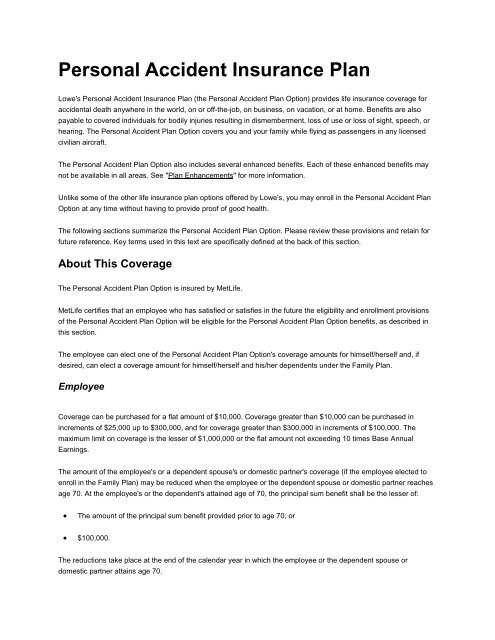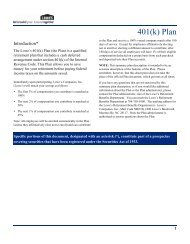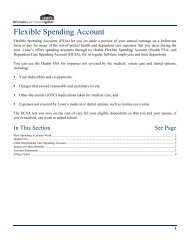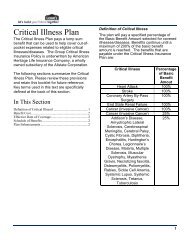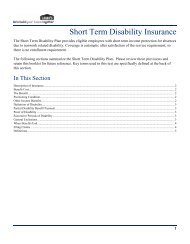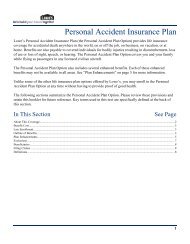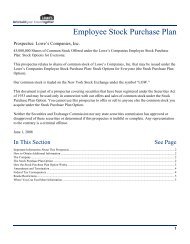Personal Accident Insurance Plan - My Lowe's Life
Personal Accident Insurance Plan - My Lowe's Life
Personal Accident Insurance Plan - My Lowe's Life
Create successful ePaper yourself
Turn your PDF publications into a flip-book with our unique Google optimized e-Paper software.
The premium rate shall remain the same, but the employee's cost will be reduced so that the employee only payspremiums based on his/her new age-reduced coverage amount. The employee may not increase coverage afterage 70.DependentsUnder the Family <strong>Plan</strong>, you can purchase up to $500,000 in coverage for your spouse or domestic partner and up to$100,000 for each eligible dependent child or domestic partner's child. The minimum amount of coverage that youmust purchase if you choose to enroll in the <strong>Personal</strong> <strong>Accident</strong> <strong>Plan</strong> Option is $10,000.Benefits under the Family <strong>Plan</strong> are calculated as a percentage of the benefit amount you select for yourself, andbased on the composition of your family at the time of loss. The percentages are as follows:• If, at the time of loss, your family consists of you and your spouse or domestic partner, but NO children, thenthe benefit under the Family <strong>Plan</strong> will be:EmployeeSpouse or Domestic Partner100% 100%• If, at the time of loss, your family consists of you, your spouse or domestic partner and dependent childrenand/or domestic partner's children, then the benefit under the Family <strong>Plan</strong> will be:Employee Spouse or Domestic Partner Each Child and/or Domestic Partner's Child100% 80% 15%• If, at the time of loss, your family consists of you and your dependent children and/or domestic partner'schildren but NO spouse or domestic partner, then the benefit under the Family <strong>Plan</strong> will be:EmployeeEach Child and/or Domestic Partner's Child100% 25%For example, if an employee selects the $100,000 benefit amount under the Family <strong>Plan</strong> and, at the time of loss, hasa spouse or domestic partner and three children, then the coverage amount would be:Employee Spouse or Domestic Partner Each Child and/or Domestic Partner's Child$100,000 $80,000 $ 15,000If, instead, an employee selects the $100,000 benefit amount under the Family <strong>Plan</strong> and, at the time of loss, hasthree children but no spouse or domestic partner, then the coverage amount would be:
EmployeeEach Child and/or Domestic Partner's Child$100,000 $25,000In addition, the amount of the insured spouse's or domestic partner's coverage under the Family <strong>Plan</strong> will decreasebased on the spouse's or domestic partner's age, as explained above under "Employee."Benefit CostThe employee pays the full cost of the <strong>Personal</strong> <strong>Accident</strong> <strong>Plan</strong> Option.Late EnrollmentIf you do not enroll in the <strong>Personal</strong> <strong>Accident</strong> <strong>Plan</strong> Option during your initial eligibility period, you can still enroll forcoverage or increase the level of coverage anytime during the year.All <strong>Personal</strong> <strong>Accident</strong> <strong>Plan</strong> enrollments, or increases in coverage, completed after the expiration of your initialeligibility period are considered late enrollments. This <strong>Personal</strong> <strong>Accident</strong> <strong>Plan</strong> Option does not require evidence ofgood health. To enroll in the <strong>Personal</strong> <strong>Accident</strong> <strong>Plan</strong> Option, visit the Empowered Benefits enrollment website(<strong>My</strong>Lowes<strong>Life</strong>><strong>My</strong>Health). Coverage becomes effective on the date you submit your enrollment online.Outline of BenefitsBenefits are payable for the events described below. The coverage amounts in effect at the time of these events willbe paid as described in the "How to File a Claim" section.Your benefit is determined by multiplying the amount of coverage that you have selected, reduced by age (whenappropriate), by the applicable fraction for the particular injury involved (see "Benefits Schedule for CoveredEmployees" and "Benefits Schedule for Covered Dependents" below). If benefits are payable under the Family <strong>Plan</strong>,this amount will be reduced based on family composition, as described under "Dependents."Example:If an employee elects $25,000 in employee coverage only, and suffers an accidental loss of one hand, benefits arepayable to the employee as follows:• 50% of $25,000 or $12,500<strong>Accident</strong>al Loss of <strong>Life</strong>, Limb (Including Loss of Use), Sight, Speech, Hearing,Coma, or Brain Damage BenefitsBenefits are paid for bodily injuries resulting in dismemberment, loss of use or loss of sight, speech hearing, coma, orbrain damage:
• Caused by an accident which happens while a person is covered by the policy; and• Which directly and from no other cause results in a covered loss.If within one year from the date of an accident covered by the policy, bodily injuries result in any of the followinglosses, the benefit amount opposite such loss in the schedule below will be paid. If the insured person sustains morethan one loss as the result of any one accident, the maximum amount paid will be the principal sum. Any <strong>Plan</strong>Enhancements that may be payable are in addition to the benefits payable under the Benefits Schedule for thecovered loss.Exposure and DisappearanceBenefits will be provided if an injury is sustained by a covered individual who is unavoidably exposed to the elementsand suffers a loss as a result, or if the individual is assumed to have suffered a loss of life due to the individual'sdisappearance, as described below.Under the <strong>Personal</strong> <strong>Accident</strong> <strong>Plan</strong> Option, a covered individual is assumed to have suffered loss of life if:• The individual is riding in a common carrier that is involved in an accident covered under this policy;• As a result of the accident, the common carrier is wrecked, sinks or disappears; and• The insured's body is not found within one year of the accident.Common DisasterA benefit is payable if a covered employee and his/her covered spouse or domestic partner die as a result of injuriessustained in the same accident. Benefits will be paid in accordance with the beneficiary designation provision or tothe designated guardian for the covered employees dependent children and/or the domestic partner's children. Boththe death of the covered employee and of the covered spouse or domestic partner must occur within 365 days of theaccident that caused the injuries resulting in death. The benefit will increase the covered spouse's or domesticpartner's benefit to equal the amount of the covered employee's benefit under the <strong>Personal</strong> <strong>Accident</strong> <strong>Plan</strong> Option.Benefits Schedule for Covered EmployeesLossBenefit Amounts<strong>Life</strong>100% of Principal sumBoth hands or both feet or sight of both eyes100% of Principal sumOne hand and one foot100% of Principal sumOne hand or foot and sight of one eye100% of Principal sumSpeech and hearing in both ears100% of Principal sum
One hand or one Foot50% of principal sumSpeech or hearing in both ears50% of principal sumSight of one eye50% of principal sumThumb and index finger of the same hand25% of principal sumHearing in one ear25% of principal sumUse of four limbs100% of Principal sumUse of three limbs100% of Principal sumUse of two limbs100% of Principal sumUse of one limb50% of principal sumIf you select the Family <strong>Plan</strong>, then the benefit amounts applicable to your family members who incur the loss of life ormember are outlined in the table below.Benefit Schedule for Covered DependentsCovered Dependent Benefit AmountsSpouse or Domestic Partner only covered100% of the employee's benefit*Spouse or Domestic Partner and children covered:Spouse or Domestic PartnerEach child and/or Domestic Partner's Child80% of the employee's benefit***15% of the employee's benefit*Children and/or Domestic Partner's Children only covered:Each child an/or Domestic Partner's Child**25% of the employee's benefit** See table above for employee benefit schedule.**Payable for death of dependent child or domestic partner's child only. Benefits payable for dismemberment and lossof use for dependent children or domestic partner's children is equal to two times the benefit shown in the tableabove.Coma BenefitBenefits will be provided to the employee and covered dependents if the employee or dependent sustains an injurythat, independent of all other causes, directly results in the individual being in a coma within 30 days of injury. Thebenefit will be paid at a rate of:
• 2% per month for a maximum of 100 months for employees; or• 2% per month for a maximum of 100 months for covered dependents.A waiting period of 31 days from the date that the insured individual becomes comatose will be applied before anypayment of coma benefits takes place.Brain Damage BenefitBenefits will be provided if a covered individual sustains an injury that, independent of all other causes, directlyresults in a traumatic brain injury causing brain damage. The benefit will be equal to 100% of the covered individual'scoverage under the <strong>Personal</strong> <strong>Accident</strong> <strong>Plan</strong> Option, if all of the following conditions are met:• The brain damage begins within 60 days of the injury,• Require hospitalization for at least 5 days, and• The brain damage continues for 12 consecutive monthsPayment of this benefit plus any other benefit payable as a result of the same accident will not exceed the <strong>Personal</strong><strong>Accident</strong> <strong>Plan</strong> Option benefit that the insured is eligible to receive.<strong>Plan</strong> EnhancementsHospital Confinement Monthly Income BenefitIf a covered person is confined in a hospital for more than three consecutive days, the covered person will receivetwo percent of his or her coverage under the <strong>Personal</strong> <strong>Accident</strong> <strong>Plan</strong> Option for each full month (1/30 of the monthlybenefit for each day of a partial month) of hospitalization, provided the following requirements are met:• The hospitalization is the result of an accident, directly and with no other causes, while coverage is in force;• The covered person is under a doctor's care; and• The hospital stay begins while the person is covered.Payments will begin after the three-consecutive-day minimum confinement period. The benefit payments cannotexceed 12 months in duration, and the monthly benefit cannot exceed $5,000.Education BenefitIf a covered employee who elected the Family <strong>Plan</strong> dies as a result of an injury within one year after the date of theaccident causing the injury, an education benefit is payable to each of the covered employee's qualified children. Forpurposes of the education benefit, a qualified child is any of the covered employee's unmarried dependent childrenunder age 26 who, on the date of the covered employee's covered death, is either:
• Enrolled as a full-time student in an accredited post-secondary institution of higher learning beyond the 12thgrade level; or• At the 12th grade level and enrolls as a full-time student in an accredited post-secondary institution of higherlearning within 365 days following the date of the covered employee's death.Met<strong>Life</strong> must receive proof that the child is a qualified child, and the qualified child must continue to be enrolled as afull-time student in an accredited post-secondary institution of higher learning for full-time students beyond the 12thgrade level.The education benefit is payable semi-annually for each child who qualifies when Met<strong>Life</strong> receives proof that tuitioncharges have been paid:• In an overall maximum amount equal to 10% of the principal sum;• Per academic year, but not more than four consecutive academic years; and• In an amount not to exceed $25,000 per academic year.Education benefits end for each qualified child on the earliest of:• The date the qualified child fails to furnish proof required or• The total maximum benefit payable under the child care benefit is paid by Met<strong>Life</strong>;If, at the time of accident, coverage is in force, but there is no dependent child who qualifies for an education benefit,an additional benefit of $1,000 will be paid to the designated beneficiary.Child-Care BenefitIf a covered employee who elected the Family <strong>Plan</strong> dies as a result of an injury within one year of the accidentcausing the injury, a child care benefit is payable to the covered employee's authorized representative for qualifiedchildren.For purposes of the child-care benefit, a qualified child is any of the covered employee's dependent children that areunder age 12 and enrolled in a licensed day-care facility, school facility, or another similar program or enrolls within12 months following date of employee death.Child-care expenses will be reimbursed for each qualified child up to a maximum $7,500 per year for four consecutiveyears not to exceed 12% of the child maximum benefit payable.If, at the time of death, the covered employee has no dependent children eligible for the child-care benefit, $2,000 willbe paid to the covered employee's designated beneficiary.Spouse or Domestic Partner Training Benefit
A spouse or domestic partner training benefit may be payable if a covered employee dies as a result of an injury.Proof that the covered employee's death is a result of an injury must be provided. The benefit covers the actual costincurred for a period of 5 years by the covered employee's dependent spouse or domestic partner for an accreditedschool commencing within 24 months from the date of the death. The total maximum amount payable is 10% of theemployee's coverage amount, but no more than $5,000 per academic year.The dependent spouse or domestic partner is eligible to receive a spouse or domestic partner training benefit ifhe/she is covered under the policy on the date of the covered employee's accident.If this benefit is in effect on the date you die and there is no Spouse or Domestic Partner who could qualify for it,Met<strong>Life</strong> will pay $1,000 to your designated beneficiary in one lump sum.Seat Belt and Air Bag BenefitIf a covered individual suffers loss of life as a result of an automobile accident, the covered individual's beneficiarymay receive a seat belt benefit of 15% of the covered individual's benefit under the <strong>Personal</strong> <strong>Accident</strong> <strong>Plan</strong> Option.The maximum seat belt benefit payable is $25,000. A seat belt benefit is payable only if:• The covered person was operating or riding in a private passenger car;• The private passenger car is equipped with seat belt(s) that meet published United States Government safetystandards, are properly installed by the car manufacturer, and not altered after installation;• The seat belt(s) were in actual use and properly fastened* at the time of the covered accident; and• The position of the seat belt(s) is certified in the official report of the covered accident, or by the investigatingofficer.A copy of the police accident report must be submitted with the claim. If the report indicates that the coveredindividual was not wearing a seat belt or was not wearing a seat belt correctly, no seat belt benefit will be paid. Inaddition, no benefit will be paid if the covered individual is the driver of the private passenger car and does not hold acurrent and valid driver's license, or if the covered individual was under the influence of alcohol or drugs.* An automatic harness seat belt is not considered fastened unless a lap belt is also used.An additional air bag benefit of $5,000 will be paid if:• The private passenger car is equipped with a single air bag and the covered individual is the driver;• The private passenger car is equipped with an air bag for both the driver and the front passenger seat, and thecovered individual is the driver or in the front passenger seat; or• The private passenger car is equipped with an air bag for the driver seat, the front passenger seat, and air bagsfor passenger seats; and the covered individual is the driver, the front seat passenger, or a rear seatpassenger; and
• The seat belt(s) are in actual use and properly fastened at the time of the covered accident.Medical Continuation BenefitIf the employee elects coverage under the Family <strong>Plan</strong> for either employee and spouse or domestic partner,employee and children, or employee and family, and the covered employee dies as the result of an injury, an amountequal to the group medical insurance premiums will be paid under the <strong>Personal</strong> <strong>Accident</strong> <strong>Plan</strong> Option to the coveredemployee's beneficiaries. Proof must be provided regarding the cause of the covered employee's death, and that thecovered spouse or domestic partner and/or children have continued medical coverage as permitted under theConsolidated Omnibus Budget Reconciliation Act (COBRA) of 1985.The maximum benefit payable under the medical continuation benefit is $5,000 per year up to a maximum benefitperiod of three years with an overall maximum payable of 5% of the full amount available under the BenefitsSchedule.ExclusionsNo benefits will be paid for loss resulting from:• Intentionally self-inflicted injuries, suicide, or any suicidal attempt while sane or insane (in Missouri, only whilesane);• War, whether declared or undeclared; or act of war, insurrection, rebellion or riot;• The voluntary intake or use by any means of;oAny drug, medication or sedative, unless it is:• Taken or used as prescribed by a Physician, or• An "over the counter" drug, medication or sedative taken as directed;oAlcohol in combination with any drug, medication, or sedative; oroPoison, gas, or fumes;• Service or full-time active duty in the armed forces of any country or international authority except the UnitedStates National Guard;• Physical or mental illness or infirmity, or diagnosis or treatment of such illness or infirmity;• Infection, other than infection occurring in an external accidental wound;• Any incident related to:
oTravel in an aircraft as a pilot, crew member, flight student or while acting in any capacity other than as apassenger;oTravel in an aircraft for the purpose of parachuting or otherwise exiting from such aircraft while it is inflight;oParachuting or otherwise exiting from an aircraft while such aircraft is in flight, except for selfpreservation;oTravel in an aircraft or device used;• For testing or experimental purposes;• By or for any military authority; or• For travel or designated for travel beyond the earth's atmosphere;• An attempt to commit or commission of a felony under state or federal law; or• The voluntary ingestion of that percentage of alcohol in the covered individual's blood that raises a presumptionthat the covered individual was driving any vehicle used for transportation while under the influence of alcohol.The blood alcohol level that raises this presumption is governed by the laws of the state in which the accidentoccurred.BeneficiariesLoss of life benefits will be paid to the beneficiary named on the personal accident (Group <strong>Life</strong> <strong>Insurance</strong> / "VoluntaryAD&D") portion of the Empowered Benefits enrollment website (<strong>My</strong>Lowes<strong>Life</strong>><strong>My</strong>Health). An employee naminghis/her spouse or domestic partner as beneficiary should show her name as Mary Jones Smith, not Mrs. John Smith,or his name as John Jones Smith, not Mr. John Smith.You will be the beneficiary for your spouse's or domestic partner's and dependent children's or domestic partner'schildren's loss of life benefits unless you designate otherwise.You may change your beneficiary at any time. You may name anyone as your beneficiary by listing his/her name (ornames, if you elect multiple beneficiaries) on the Empowered Benefits enrollment website (<strong>My</strong>Lowes<strong>Life</strong>><strong>My</strong>Health).The effective date of the change is the date you submit your change request on the Empowered Benefits web site.However, neither <strong>Lowe's</strong> nor Met<strong>Life</strong> is liable for any amount paid before the request is submitted online.The beneficiary's consent to the change is NOT required.Filing ClaimsWritten notice of a claim must be given within 180 days after a covered loss begins, or as soon as reasonablypossible. Forward the completed claim form to Met<strong>Life</strong>. Met<strong>Life</strong> will certify coverage under the <strong>Personal</strong> <strong>Accident</strong> <strong>Plan</strong>Option. When the claim has been processed, you or your beneficiary will be notified of the benefits paid.
If there is no surviving beneficiary, your loss of life benefits will be paid to the first surviving class of the followingclasses of beneficiaries:• Spouse or domestic partner of the covered person;• Children, and/or domestic partner's children, equally, if living; otherwise to their descendents based on theterms of the policy;• Parents, equally, or to the survivor; or• Brothers or sisters, equally, or to the survivor or survivors.If there are no surviving members of the above, benefits will be paid to your estate. All other benefits will be paid toyou.Met<strong>Life</strong> will pay the cost and have the right to have the covered person examined as often as reasonably necessarywhile a claim is pending. Met<strong>Life</strong> may have an autopsy made, at the company's expense, unless prohibited by law.No legal action to get policy benefits may be brought less than 60 days nor more than three years (Kansas, fiveyears; South Carolina, six years) after written proof of loss has been furnished as required by the policy.The policy is not in lieu of and does not affect any requirement for coverage under any workers' compensationinsurance.DefinitionsBase Annual Earnings: For hourly and salaried employees, the gross annual income in effect just prior to the date ofloss. It includes your total income before taxes. It is prior to any deductions made for pretax contributions to aqualified deferred compensation plan, Section 125 plan, or Flexible Spending Account. It does not include incomereceived from commissions, bonuses, overtime pay, incentive compensation (such as stock options or grants), anyother extra compensation, or income received from sources other than <strong>Lowe's</strong>.Doctor:• A person performing tasks that are within the limits of his/her medical license; and• A person who is licensed to practice medicine, to prescribe and administer drugs or to perform surgery; or aperson with a doctoral degree in psychology (Ph.D. or Psy.D.) whose primary practice is treating patients; or• A person who is a legally qualified medical practitioner, according to the laws and regulations of the governingjurisdiction.Met<strong>Life</strong> will not recognize the insured, or the insured's spouse or domestic partner, children and/or domestic partner'schildren, parents, or siblings as a doctor for a claim that the insured sends to Met<strong>Life</strong>.Hospital: A legally created institution that:
• Is mainly for the care and treatment of sick, ailing or injured inpatients;• Is run by a staff of one or more doctors available at all times;• Provides nursing service at all times;• Provides organized diagnostic and surgical facilities; and• Is not primarily a clinic or facility for convalescence, rest, nursing, custody, extended care, or a facility for theelderly, drug addicts, or alcoholics.Loss of foot: All of the foot is severed at or above the ankle joint.Loss of hand: All of the hand is severed at or above the wrist.Loss of hearing: The total and irrevocable loss of hearing in both ears that continues for 12 consecutive monthsfollowing accidental injury.Loss of sight: Permanent and uncorrectable loss of sight in the eye. Visual acuity must be 20/200 or worse in theeye or the field of vision must be less than 20 degrees.Loss of speech: The total and irrevocable loss of speech that continues for 12 consecutive months followingaccidental injury.Loss of thumb and index finger: The whole thumb and index finger are cut off at or above the joint closest to thewrist.Loss of use: The total paralysis of a limb or limbs that is determined by competent medical authority to bepermanent, complete, and irreversible.


